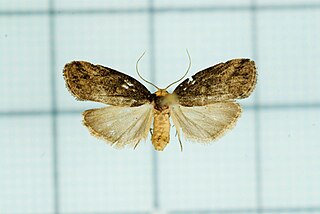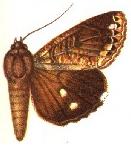
Eugoa is a genus in the family Erebidae, subfamily Arctiinae. The genus was erected by Francis Walker in 1858. They are found in India, Sri Lanka, Myanmar and Borneo.

Ercheia is a genus of moths in the family Erebidae. The genus was erected by Francis Walker in 1858.
America is a genus of moths in the family Erebidae erected by Achille Guenée in 1852.

Mocis is a genus of moths in the family Erebidae. The genus was erected by Jacob Hübner in 1823.

Collix is a genus of moths in the family Geometridae first described by Achille Guenée in 1857.
Ercheia kebea is a species of moth of the family Erebidae. It is found in Thailand, Sumatra, Borneo, Seram, New Guinea, Queensland, east to Fiji.

Ercheia cyllaria is a species of moth of the family Erebidae first described by Pieter Cramer in 1779. It is found in the Indian subregion, Sri Lanka, Taiwan, Japan, Indochina, Thailand, Peninsular Malaysia, Sumatra, Borneo, Seram and the Kai Islands.

Ercheia pulchrivenula is a species of moth of the family Erebidae. It is found in Thailand, Peninsular Malaysia, Sumatra and Borneo.

Ercheia pulchrivena is a species of moth of the family Erebidae first described by Francis Walker in 1864. It is found on Sumatra and Borneo.

Ercheia dubia is a species of moth of the family Erebidae first described by Arthur Gardiner Butler in 1874. It is found in Asia and in Australia and New Guinea

Ercheia quadriplaga is a species of moth of the family Erebidae. It is found in Asia, including Sulawesi.

Ercheia umbrosa is a species of moth of the family Erebidae. It is found in Japan, Korea, China and India.

Risoba is a genus of moths of the family Nolidae erected by Frederic Moore in 1881.

Euclera diversipennis is a species of moth of the subfamily Arctiinae first described by Francis Walker in 1854. It is found in Brazil and Peru.

Ercheia niveostrigata is a species of moth of the family Erebidae first described by Warren in 1913. It is found in Taiwan.
Ercheia mahagonica is a species of moth of the family Erebidae first described by Saalmüller in 1891. It is found in Ghana and Madagascar.
Ercheia subsignata is a species of moth of the family Erebidae. It is found in the Republic of Congo, the Democratic Republic of Congo, Ethiopia, Gabon, Ghana, Kenya, Malawi, Nigeria, Sierra Leone and São Tomé & Principe.
Zura or Zur'a may refer to:

Risoba diversipennis is a species of tuft moth native to the Himalayas, Indochina and to Papua New Guinea. It was described by Francis Walker in 1858. Recorded host plants are Melastoma.









